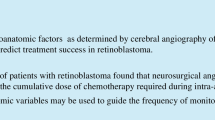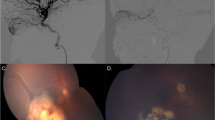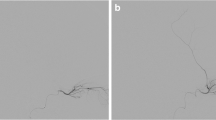Abstract
Background
Intra-arterial chemotherapy (IAC) represents a mainstay of retinoblastoma treatment in children. Patients with retinoblastoma are uniquely at risk for secondary malignancies and are sensitive to the ionizing effects of radiation.
Objective
To retrospectively review a single institution’s experience with IAC for retinoblastoma and the effect of variable intra-procedural imaging techniques on radiation exposure.
Materials and methods
Twenty-four consecutive patients, with a mean age of 30.8±16.3 months (range: 3.2–83.4 months), undergoing IAC for retinoblastoma between May 2014 and May 2020 (72 months) were included. No patients were excluded. The primary outcome was radiation exposure and secondary outcomes included technical success and procedural adverse events. Technical success was defined as catheterization of the ophthalmic or meningolacrimal artery and complete delivery of chemotherapy. Each procedure was retrospectively reviewed and categorized as one of five imaging protocol types. Protocol types were characterized by uniplanar versus multiplanar imaging and digital subtraction angiographic versus roadmap angiographic techniques. Radiation exposure, protocol utilization, the association of protocol and radiation exposure were assessed.
Results
During 96 consecutive interventions, 109 ocular treatments were performed. Thirteen of the 96 (15.5%) treatments were bilateral. Ocular technical success was 106 of 109 (97.2%). All three treatment failures were successfully repeated within a week. Mean fluoroscopy time was 6.4±6.2 min (range: 0.7–31.1 min). Mean air kerma was 36.2±52.2 mGy (range: 1.4–215.0 mGy). There were two major (1.8%) complications and four (3.7%) minor complications. Of the 96 procedures, 10 (10.4%), 9 (9.4%), 13 (13.5%), 28 (29.2%) and 36 (37.5%) were performed using protocol types A, B, C, D and E, respectively. For protocol type A, mean fluoroscopy time was 10.3±6.8 min (range: 3.0–25.4 min) and mean air kerma was 118.2±61.2 mGy (range: 24.5–167.3 mGy). For protocol type E, mean fluoroscopy time was 3.1±3.2 min (range: 0.7–15.1 min) and mean air kerma was 5.4±4.2 mGy (range: 1.4–19.5 mGy). Fluoroscopy time and air kerma decreased over time, corresponding to the reduced use of multiplanar imaging and digital subtraction angiography. In the first quartile (procedures 1–24), 8 (33.3%), 7 (29.2%), 2 (8.3%), 6 (25.0%) and 1 (4.2%) were performed using protocol types A, B, C, D and E, respectively. Mean fluoroscopy time was 10.5±8.2 min (range: 2.4–28.1 min) and mean air kerma was 84.2±71.6 mGy (range: 12.8–215.0 mGy). In the final quartile (procedures 73–96), 24 (100%) procedures were performed using protocol type E. Mean fluoroscopy time was 3.5±4.0 min (range: 0.7–15.1 min) and mean air kerma was 5.0±4.3 mGy (range: 1.4–18.0 mGy), representing 66.7% and 94.1% reductions from the first quartile, respectively. Technical success in the second half of the experience was 100%.
Conclusion
Sequence elimination, consolidation from biplane imaging to lateral-only imaging, and replacing digital subtraction with roadmap angiography dramatically reduced radiation exposure during IAC for retinoblastoma without adversely affecting technical success or safety.




Similar content being viewed by others
References
Shields CL, Shields JA (2010) Retinoblastoma management: advances in enucleation, intravenous chemoreduction, and intra-arterial chemotherapy. Curr Opin Ophthalmol 21:203–212
Broaddus E, Topham A, Singh AD (2009) Survival with retinoblastoma in the USA: 1975–2004. Br J Ophthalmol 91:24–27
MacCarthy A, Birch JM, Draper GJ et al (2009) Retinoblastoma: treatment and survival in Great Britain 1963 to 2002. Br J Ophthalmol 93:38–39
Gobin YP, Dunkel IJ, Marr BP et al (2011) Intra-arterial chemotherapy for the management of retinoblastoma: four-year experience. Arch Ophthalmol 129:732–737
Goske MJ, Applegate KE, Boylan J et al (2008) The image gently campaign: working together to change practice. AJR Am J Roentgenol 190:273–274
Society for Pediatric Radiology (2002) The ALARA (as low as reasonably achievable) concept in pediatric CT intelligent dose reduction. Pediatr Radiol 32:217–313
Sidhu M, Goske MJ, Connolly B et al (2010) Image gently, step lightly: promoting radiation safety in pediatric interventional radiology. AJR Am J Roentgenol 195:W299–W301
National Research Council (2006) Health risks from exposure to low levels of ionizing radiation: BEIR VII Phase 2. The National Academies Press, Washington, DC. https://doi.org/10.17226/11340
Moll AC, Imhof SM, Schouten-Van Meeteren AY et al (2001) Second primary tumors in hereditary retinoblastoma: a register-based study, 1945–1997: is there an age effect on radiation-related risk? Ophthalmology 108:1109–1114
Draper GJ, Sanders BM, Kingston JE (1986) Second primary neoplasms in patients with retinoblastoma. Br J Cancer 53:661–671
Kleinerman RA (2009) Radiation-sensitive genetically susceptible pediatric sub-populations. Pediatr Radiol 39(Suppl 1):S27–S31
Wong FL, Boice JD Jr, Abramson DH et al (1997) Cancer incidence after retinoblastoma: radiation dose and sarcoma risk. JAMA 278:1262–1267
MacCarthy A, Bayne AM, Brownbill PA et al (2013) Second and subsequent tumours among 1927 retinoblastoma patients diagnosed in Britain 1951–2004. Br J Cancer 108:2455–2463
Obesso A, Alejo L, Huerga C et al (2019) Eye lens radiation exposure in paediatric interventional treatment of retinoblastoma. Sci Rep 9:20113
Vandenbroucke JP, von Elm E, Altman DG et al (2007) Strengthening the reporting of observational studies in epidemiology (STROBE): explanation and elaboration. PLoS Med 4:e297
Khalilzadeh O, Baerlocher MO, Shyn PB et al (2017) Proposal of a new adverse event classification by the society of interventional radiology standards of practice committee. J Vasc Intervent Radiol 28:1432–1437
Boddu SR, Abramson DH, Marr BP et al (2017) Selective ophthalmic artery chemosurgery (SOAC) for retinoblastoma: fluoroscopic time and radiation dose parameters. A baseline study. J Neurointerv Surg 9:1107–1112
Guasti A, Leonini S, Bertelli E et al (2019) Intra-arterial chemotherapy for retinoblastoma: the dosimetric impact. Neuroradiology 61:1083–1091
Area C, Yen CJ, Chevez-Barrios P et al (2019) Technical and anatomical factors affecting intra-arterial chemotherapy fluoroscopy time and radiation dose for intraocular retinoblastoma. J Neurointerv Surg 11:1273–1276
Qureshi AM, Davies LK, Patel PA et al (2019) Determinants of radiation dose in selective ophthalmic artery chemosurgery for retinoblastoma. AJNR Am J Neuroradiol 40:713–717
Cooke DL, Stout CE, Kim WT et al (2014) Radiation dose reduction in intra-arterial chemotherapy infusion for intraocular retinoblastoma. J Neurointerv Surg 6:785–789
van Strijen MJ, Grünhagen T, Mauti M et al (2015) Evaluation of a noise reduction imaging technology in iliac digital subtraction angiography: noninferior clinical image quality with lower patient and scatter dose. J Vasc Interv Radiol 26:642–650.E.1
Racadio J, Strauss K, Abruzzo T et al (2014) Significant dose reduction for pediatric digital subtraction angiography without impairing image quality: preclinical study in a piglet model. AJR Am J Roentgenol 203:904–908
Kraemer BF, Tesche C, Hapfelmeier A et al (2020) Radiation dose reduction using a novel fluoroscopy system in patients undergoing diagnostic invasive coronary angiography. J Thorac Imaging. https://doi.org/10.1097/rti.0000000000000510
Author information
Authors and Affiliations
Corresponding author
Ethics declarations
Conflicts of interest
Eric J. Monroe is a scientific adviser and speaker for Biogen. Jeffrey Forris Beecham Chick is a consultant and speaker for Guerbet and C.R. Bard. Danial K. Hallam is a consultant for Medtronic.
Additional information
Publisher’s note
Springer Nature remains neutral with regard to jurisdictional claims in published maps and institutional affiliations.
Rights and permissions
About this article
Cite this article
Monroe, E.J., Chick, J.F.B., Stacey, A.W. et al. Radiation dose reduction during intra-arterial chemotherapy for retinoblastoma: a retrospective analysis of 96 consecutive pediatric interventions using five distinct protocols. Pediatr Radiol 51, 649–657 (2021). https://doi.org/10.1007/s00247-020-04892-x
Received:
Revised:
Accepted:
Published:
Issue Date:
DOI: https://doi.org/10.1007/s00247-020-04892-x




